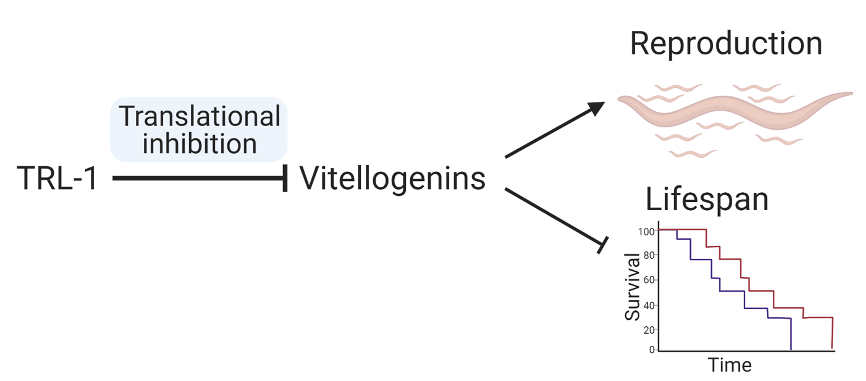How does aging evolve? George C. Williams proposed antagonistic pleiotropy as an evolutionary explanation for aging in 1957. Pleiotropy is a phenomenon in which a single gene controls many traits. Antagonistic pleiotropy means that some traits regulated by a gene are beneficial to early life adaptation, while others are detrimental to later life. Life is forced to accept late harm as the necessary cause of early advantage, that is, life cannot achieve perfection through natural selection. Although the theory of antagonistic pleiotropy has gained some supporting evidence at the physiological level, the direct molecular evidence remains limited.
On April 28, 2022, Guangshuo Ou's research group at the School of Life Sciences, Tsinghua University, published a research article online in the journal " Proc Natl Acad Sci U S A " entitled " An antagonistic pleiotropic gene regulates the reproduction and longevity tradeoff ", and which reported that the antagonistic pleiotropic gene trl-1 regulates the trade-off between reproduction and longevity.
Using ribosome profiling, Guangshuo Ou's group analyzed proteomic changes in C. elegans during recovery from starvation and found that an open reading frame trl-1 "hidden" in an annotated pseudogene was significantly translated during post-starvation re-feeding (Figure 1). trl-1 mutants, while increasing the number of offspring, shorten lifespan and impair the longevity induced by reproductive defects. The absence of TRL-1 abnormally upregulates the translation of vitellogenin, which provides essential nutrients for embryonic development, and thus increases the number of offspring, whereas the overexpression of vitellogenin reduces lifespan. At the biochemical level, TRL-1 protein recruits vitellogenin mRNA through liquid-liquid phase separation and inhibits its translation. These results suggest that TRL-1, as an antagonistic pleiotropic gene, regulates the tradeoff between reproduction and longevity by optimizing the nutritional yield of the next generation (Figure 2).

Figure 1. The novel open reading frame TRL-1 is significantly translated after starvation refeeding

Figure 2. TRL-1 regulates the reproduction and longevity tradeoff by recruiting vitellogenins mRNA through liquid-liquid separation (LLPS) and inhibiting its translation.
Dr. Guangshuo Ou of the School of Life Sciences, Tsinghua University, is the corresponding author, and former Ph.D. student Dr. Dou Wu is the first author of this article. Dr. Di Chen at Nanjing University provided longevity data for this study. This research was supported by the Tsinghua-Peking Center for Life Sciences, the Ministry of Science and Technology, the National Natural Science Foundation of China and other related institutions.
Original Article Link:https://doi.org/10.1073/pnas.2120311119
Editors: John Olbrich, Li Han

